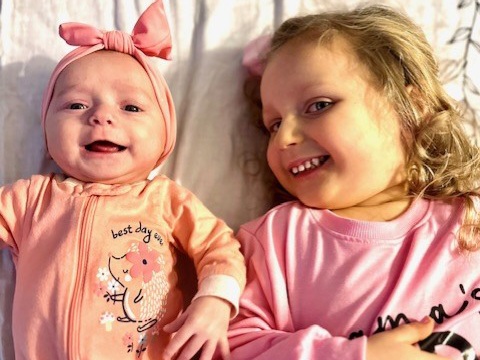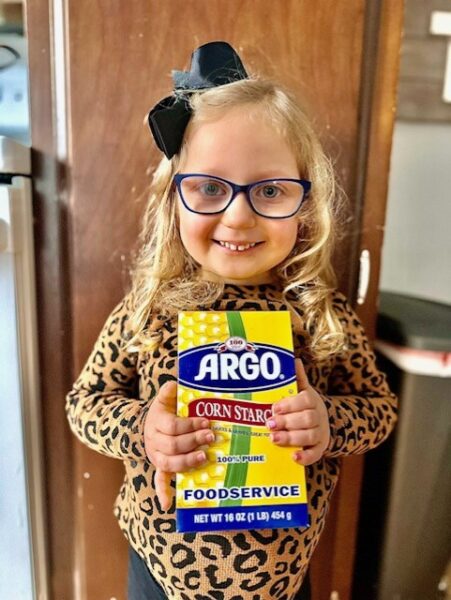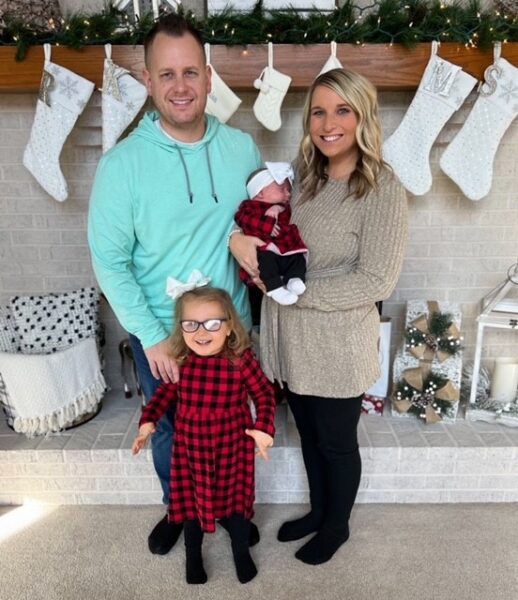
Claire and Quinn Williams are sisters who have the same rare disease, glycogen storage disease type 1A (GSD1A), which affects one in 20,000 people. GSD1A is a lifelong condition that blocks the liver from releasing sugar into the blood and causes severe hypoglycemia.
Richie and Kelsey Williams of Massillon, Ohio looked forward to their date night. It was their first outing since becoming parents. They planned to go to a friend’s wedding and Richie’s parents agreed to watch their five-month-old daughter, Quinn.
“My mom called while we were out and said Quinn was sick and throwing up every time she ate,” Richie said. “My mom, who is a nurse, was concerned by how distended Quinn’s belly was. She said that was abnormal. We left the wedding early to take Quinn home.”
The following Monday, they took Quinn to her pediatrician. Quinn’s doctor examined her and scheduled an ultrasound the next day to check her abdomen. The Williamses had just returned home after the ultrasound when the pediatrician’s office called with bad news. Quinn’s liver was enlarged and she should go to Akron Children’s Emergency Room (ER) right away.
Over the next 10 days, Quinn underwent numerous tests in the ER before Richie and Kelsey learned what was wrong. Quinn had a rare metabolic disease called glycogen storage disease type 1A (GSD1A) which blocks the liver from releasing sugar into the blood. GSD1A results in severe hypoglycemia (low blood sugar) and can cause enlarged liver and kidneys, impaired growth and delayed puberty. There is a one in 20,000 chance of a person acquiring this lifelong condition.
Managing a rare disease
The Williamses found help and support through Akron Children’s Genetic Center’s Metabolic Disorders Clinic, Not only did the clinic’s multidisciplinary team answer their questions about GSD1A and its treatment, they also taught Richie and Kelsey how to care for Quinn at home and manage her disease going forward.

Three-year-old Quinn Williams holds a box of Argo cornstarch, which is a mainstay in her diet.
The time and effort involved in caring for Quinn required the couple to be hands-on around the clock. For instance, Quinn’s glucose levels were monitored eight times daily, which required a heel or finger prick to test her blood sugar. She needed to be fed every two to three hours with a soy formula/Argo cornstarch mixture. When Quinn switched to this new formula, she had to be syringe fed because she disliked the texture and wouldn’t use her bottle.
“Some children with glycogen storage disease are fed through a gastrostomy tube, or G tube,” Kelsey said. “We didn’t want to go that route with Quinn and had to power through her feedings, especially when she began eating baby food, which is also mixed with cornstarch to maintain Quinn’s blood sugar for a longer period of time.”
Welcoming a new baby
Before Richie and Kelsey decided to have another baby, they had genetic testing done. They found out they both carried a recessive gene for GSD1A, giving them a 20 to 25 percent chance of having a child with the same condition as Quinn.

Richie and Kelsey Williams pose with their daughters, Quinn, 3, and newborn Claire. Richie’s aunt has dubbed them the “courageous and strong sisters of GSD1A” in the GoFundMe she created for their family.
Last November, 2023, the Williamses welcomed their second child, Claire. All babies born in Ohio undergo a newborn screening that tests for more than 20 disorders. Since that screening doesn’t check for GSD1A, Claire was tested in December, 2023. Unfortunately, she tested positive for GSD1A.
“When I heard the results, I fell to the floor crying,” Kelsey said. “I knew we had handled Quinn’s disease and learned from it. But could I do this with two kids?”
This time, Kelsey knew they were better prepared. For starters, they had found support and community.
Using their resources
In the three years since Quinn was diagnosed, the Williamses have come to rely on Children’s Genetic Centers specialists, including its geneticist, nurse case manager, nurse practitioner and dietitian.
“I often tell families who have just learned their child has a rare disease, ‘We are part of your family now,’” said Morgan Collier, Akron Children’s Genetic Center family nurse practitioner. “We want them to know we are here to help their child navigate through this disease and that we will be here with them, starting from infancy all the way through elder adulthood.”
Kelsey stopped working after Quinn’s diagnosis, while Richie picked up an extra day at his job. They were able to turn to their families for help, as well as find statewide services. For instance, Quinn’s pediatrician told them about the Ohio Department of Health Help Me Grow program. Additionally, Richie’s aunt set up a GoFundMe to help them.
“I used to be hesitant to use these resources, but they have helped us,” said Kelsey, who recently returned to work at a daycare which Claire and Quinn attend. “It’s part of the advice we give to the families we mentor. It’s okay to rely on your village.”

Quinn Williams’ parents, Richie and Kelsey, have a motto, “We’re not quitters.” Neither is their daughter, Quinn, who wears her superhero cape to show she’s a fighter against her lifelong rare disease.
Richie and Kelsey have a motto: “We’re not quitters.” When things felt insurmountable, they applied this motto to the situation, their marriage and/or themselves. Their positive approach is one reason they were invited to be speakers at Children’s Genetic Center’s inaugural 2023 Rare Disease Day. The event raises awareness and support for people living with rare diseases and provides advice and understanding. This year, Children’s Rare Disease Day is being held on February 29.
Learn more about Akron Children’s Rare Disease Day here.










